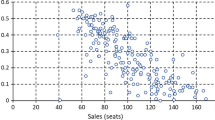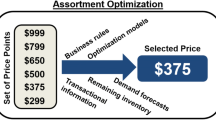Abstract
Internet advertising is a sophisticated game in which the many advertisers “play” to optimize their return on investment. There are many “targets” for the advertisements, and each “target” has a collection of games with a potentially different set of players involved. In this paper, we study the problem of how advertisers allocate their budget across these “targets”. In particular, we focus on formulating their best response strategy as an optimization problem. Advertisers have a set of keywords (“targets”) and some stochastic information about the future, namely a probability distribution over scenarios of cost vs click combinations. This summarizes the potential states of the world assuming that the strategies of other players are fixed. Then, the best response can be abstracted as stochastic budget optimization problems to figure out how to spread a given budget across these keywords to maximize the expected number of clicks.
We present the first known non-trivial poly-logarithmic approximation for these problems as well as the first known hardness results of getting better than logarithmic approximation ratios in the various parameters involved. We also identify several special cases of these problems of practical interest, such as with fixed number of scenarios or with polynomial-sized parameters related to cost, which are solvable either in polynomial time or with improved approximation ratios. Stochastic budget optimization with scenarios has sophisticated technical structure. Our approximation and hardness results come from relating these problems to a special type of (0/1, bipartite) quadratic programs inherent in them. Our research answers some open problems raised by the authors (in Algorithmica, 58(4):1022–1044, 2010).







Similar content being viewed by others
Notes
See, for example, Traffic Estimator at http://adwords.google.com/support/aw/bin/answer.py?hl=en&answer=8692, bidding tutorial at http://adwords.google.com/support/aw/bin/answer.py?hl=en&answer=163828 and bid simulator at http://adwords.google.com/support/aw/bin/answer.py?hl=en&answer=138148.
See www.google.com/trends?q=beach%2C+snow&ctab=0&geo=all&date=all&sort=0 for yearly and www.google.com/trends?q=clubs%2C+stocks&ctab=0&geo=all&date=mtd&sort=0 for weekly trends.
Our discussion can easily be adopted to other internet ad channels like display ads and behavioral targeting.
Scenarios can be provided by the search engine for the advertisers, or used by the search engines to bid on behalf of advertisers. Similarly, advertisers and other search engine optimizers can also “infer” scenarios indirectly using trends and other data provided by search engines.
The underlying assumption is that, within a scenario, the queries and keywords are well-mixed and, when budget runs out, the ad campaign is halted for the period as is currently done. The queries and keywords are well-mixed not only because of aggregation of streams from millions of users but also because of ad throttling that spreads out the eligible ad campaigns over the period of a scenario. See [19] for exact details of justification.
Throughout the paper, the notation poly(a) denotes a polynomial in a, i.e., a c for some positive constant c.
For example, the stretch parameter κ allows us to model situations such as when the real costs can be drawn from a probability distribution with a mean around \(\frac{1+\kappa}{2}d_{j}\) with a negligible probability of occurring outside a range of \(\pm\frac{1-\kappa}{2}d_{j}\) of the mean. Note that this is just an illustration. We do not assume any specific probability distribution for the variations of the real costs per click except that it varies within an interval of length κ.
For example, see https://adwords.google.com/select/TrafficEstimatorSandbox.
See for example, http://algo.research.googlepages.com/ec09-partI.pdf.
By other strategies, we mean strategies in which the advertiser does not fix the strategies of other advertisers.
The reader is reminded that κ=O(poly(log(m+n))).
See for example, http://algo.research.googlepages.com/ec09_pub.pdf.
Remember that in Sect. 2.5 we fixed bounds on κ, namely, κ=O(poly(log(m+n))).
Our reduction approach should also work if we start with MAX-2SAT-k for any constant k.
The running time is not strongly polynomial since the input size depends polynomial on log2 y (see Sect. 2.5).
References
Alon, N., Naor, A.: Approximating the cut-norm via Grothendieck’s inequality. SIAM J. Comput. 35, 787–803 (2006)
Aggarwal, G., Goel, A., Motwani, R.: Truthful auctions for pricing search keywords. In: 7th ACM Conference on Electronic Commerce, pp. 1–7 (2006)
Berman, P., Karpinski, M.: On some tighter inapproximability results, further improvements. Electronic Colloquium on Computational Complexity 5(29) (1998)
Borgs, C., Chayes, J., Etesami, O., Immorlica, N., Jain, K., Mahdian, M.: Dynamics of bid optimization in online advertisement auctions. In: 16th International World Wide Web Conference, pp. 531–540 (2007)
Bu, T.-M., Deng, X., Qi, Q.: Forward looking Nash equilibrium for keyword auction. Inf. Process. Lett. 105(2), 41–46 (2008)
Cary, M., Das, A., Edelman, B., Giotis, I., Heimerl, K., Karlin, A.R., Mathieu, C., Schwarz, M.: Greedy bidding strategies for keyword auctions. In: 8th ACM Conference on Electronic Commerce, pp. 262–271 (2007)
Chekuri, C., Khanna, S.: A PTAS for the multiple knapsack problem. SIAM J. Comput. 35(3), 713–728 (2006)
Cocco, F., Consiglio, A., Zenios, S.: Scenario Optimization asset and liability modeling for endowments with guarantees, Wharton Financial Institutions Center WP No. 00-41, June 12 (2000). Available at http://ssrn.com/abstract=253039 or doi:10.2139/ssrn.253039
Dembo, R.S.: Scenario optimization. Ann. Oper. Res. 30(1), 63–80 (1991)
Edelman, B., Ostrovsky, M., Schwarz, M.: Internet advertising and the generalized second price auction: selling billions of dollars worth of keywords. Am. Econ. Rev. 97(1), 242–259 (2007)
Feldman, J., Muthukrishnan, S., Pál, M., Stein, C.: Budget optimization in search-based advertising auctions. In: 8th ACM Conference on Electronic Commerce, 40–49 (2007)
Garey, M.R., Johnson, D.S.: Computers and Intractability—A Guide to the Theory of NP-Completeness. Freeman, New York (1979)
Goemans, M.X., Williamson, D.P.: Improved approximation algorithms for maximum cut and satisfiability problems using semidefinite programming. J. ACM 42, 1115–1145 (1995)
Håstad, J.: Clique is hard to approximate within n 1−ε. Acta Math. 182, 105–142 (1999)
Mausser, H., Rosen, D.: Applying scenario optimization to portfolio credit risk. J. Risk Finance 2(2), 36–48 (2001)
Jansen, K.: Parameterized approximation scheme for the multiple knapsack problem. SIAM J. Comput. 39(4), 1392–1412 (2009)
Lawler, E.L.: Fast approximation algorithms for knapsack problems. Math. Oper. Res. 4(4), 339–356 (1979)
Motwani, R., Raghavan, P.: Randomized Algorithms. Cambridge University Press, Cambridge (1995)
Muthukrishnan, S., Pál, M., Svitkina, Z.: Stochastic models for budget optimization in search-based advertising. Algorithmica 58(4), 1022–1044 (2010)
Varian, H.: Position auctions. Int. J. Ind. Organ. 25(6), 1163–1178 (2007)
Vazirani, V.: Approximation Algorithms. Springer, Berlin (2001)
Zenios, S.A. (ed.): Financial Optimization. Cambridge University Press, Cambridge (1996)
Zhou, Y., Chakrabarty, D., Lukose, R.: Budget constrained bidding in keyword auctions and online knapsack problems. In: 4th International Workshop on Internet and Network Economics, pp. 566–576 (2008)
Author information
Authors and Affiliations
Corresponding author
Rights and permissions
About this article
Cite this article
DasGupta, B., Muthukrishnan, S. Stochastic Budget Optimization in Internet Advertising. Algorithmica 65, 634–661 (2013). https://doi.org/10.1007/s00453-012-9614-x
Received:
Accepted:
Published:
Issue Date:
DOI: https://doi.org/10.1007/s00453-012-9614-x




